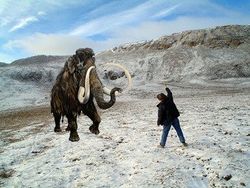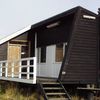12.6.2009 | 00:01
Ekki vissi ég žetta žó ég žykist vita margt.
Mikiš varš ég hissa žegar ég greip ķ tķmaritiš National Geograpic į lęknastofu ķ dag og komst aš žvķ aš ullarfķlar lifšu į Wrangler eyju allt til 1700 fyrir Kristburš. Alltaf velt fyrir mér örlögum žeirra og spekśleraš hvort hęgt vęri aš endurlķfga žį. Skilst aš žaš sé hęgt meš nśtķmatękni. Žegar ég googlaši eyjuna kom ķ ljós aš Vilhjįlmur Stefįnsson, kanadķski vestur Ķslendingurinn stóš tvisvar fyrir leišöngrum žangaš sem endušu bįšir illa:
Wrangel Island
During the last ice age, woolly mammoths (Mammuthus primigenius) lived on Wrangel Island in the Arctic Ocean. It has been shown that mammoths survived on Wrangel Island until 1700 B.C.E., the most recent survival of any known mammoth population. They also survived on Saint Paul Island in the Bering Sea until 6000 B.C.E.[9] Wrangel Island is thought to have become separated from the mainland by 12,000 years BP. Survival of a mammoth population may be explained by local geographic, topographic and climatic features, which entailed preservation of communities of steppe plants, as well as a degree of isolation sufficient to delay colonization by humans. St. Paul Island shares this characteristic of geographic isolation, implying that human hunting played a role in the disappearance of the woolly mammoth. Wrangel Island mammoths ranged from 180-230 cm in shoulder height and were for a time considered "dwarf mammoths".[10] However this classification has been re-evaluated and since the Second International Mammoth Conference in 1999, these mammoths are no longer considered to be true "dwarf mammoths".
http://en.wikipedia.org/wiki/Dwarf_elephant
Stefansson expedition survivors
In 1914, the survivors of the ill-equipped Canadian Arctic Expedition, organized by Vilhjalmur Stefansson, were marooned there for nine months after their ship, the Karluk, was crushed in the ice pack[11]. The survivors were rescued by the American motorized fishing schooner King & Winge[12] after Captain Robert Bartlett walked across the Chukchi Sea to Siberia to summon help.
[edit]1921 Second Stefansson expedition fiasco
In 1921 Wrangel Island would become the stage for one of history's tragedies when Stefansson sent five settlers (one Canadian, three Americans, and one Inuit) in a speculative attempt to claim the island for Canada[13]. The explorers were handpicked by Stefansson based upon their previous experience and academic credentials. Stefansson considered those with advanced knowledge in the fields of geography and science for this expedition. At the time, Stefansson claimed that his purpose was to head off a possible Japanese claim [14]. The initial group consisted of Allan Crawford of Canada, and Fred Maurer, Lorne Knight and Milton Galle of the US. An attempt to relieve this group in 1922 was thwarted when the schooner Teddy Bear under Captain Joe Bernard became stuck in the ice [15]. In 1923, the sole survivor of the Wrangel Island expedition, the Inuk Ada Blackjack, was rescued by a ship that left another party of 13 (American Charles Wells and 12 Inuit). In 1924, the Soviet Union removed the members of this settlement and established the settlement that survives to this day on the island.
Flokkur: Stjórnmįl og samfélag | Breytt s.d. kl. 01:42 | Facebook




 bjarnihardar
bjarnihardar
 gmaria
gmaria
 hildurhelgas
hildurhelgas
 jensgud
jensgud
 magnusthor
magnusthor
 mal214
mal214
 pjeturstefans
pjeturstefans





Bęta viš athugasemd [Innskrįning]
Ekki er lengur hęgt aš skrifa athugasemdir viš fęrsluna, žar sem tķmamörk į athugasemdir eru lišin.